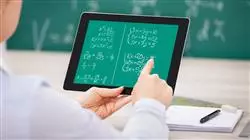University certificate
The world's largest faculty of education”
Introduction to the Program
You will advance in your professional career as a teacher, through a Innovation and Entrepreneurship in Education that will introduce you to Innovation and Entrepreneurship in Education"

The speed required to respond to new challenges in the education sector, together with the incorporation of new techniques and technological tools in the classroom, forces teachers to be constantly on top of trends in their field. In addition, the design of educational programs aimed at Innovation and Entrepreneurship in Education, requires knowledge that awakens the entrepreneurial spirit and enhances specific skills from childhood.
An attractive challenge for teaching professionals, who currently have an excellent opportunity to implement initiatives aimed at the entrepreneurial culture and to apply new methodologies that enrich, through ICT, their students’ learning experience. This Professional master’s degree is in response to the demand of teachers requiring extensive knowledge in this emerging field, a necessity attended to by public and private institutions today.
Professionals are provided with a program taught exclusively online that offers them an immersion in entrepreneurship as agents of change, in classroom gamification, as well as in innovation and improvement of teaching practices. All this with state-of-the-art teaching material, in which TECH has used the latest technology applied to academic teaching.
An excellent opportunity to pursue a flexible specialization program that can be accessed conveniently whenever and wherever students want. They will only require an electronic device with internet connection, which will allow them to access the complete syllabus from the start of the program. With no classroom attendance or fixed class schedules, graduates are offered a flexible university education that gives them the opportunity to combine their professional and work responsibilities.
Integrate the most innovative approaches in education into your knowledge and apply the latest digital tools and techniques in the classroom"
This Professional master’s degree in Innovation and Entrepreneurship in Education contains the most complete and up-to-date program on the market. The most important features include:
- Case studies presented by experts in Education Innovation
- Graphic, schematic, and practical contents created to provide scientific and practical information on the disciplines that are essential for professional practice
- Practical exercises where self-assessment can be used to improve learning
- Special emphasis on innovative methodologies
- Theoretical lessons, questions to the expert, debate forums on controversial topics, and individual reflection assignments
- Content that is accessible from any fixed or portable device with an Internet connection
Enroll in a Professional master’s degree that will bring you closer to inclusive and bilingual educational programs in a practical and theoretical way, and with special emphasis on the most modern teaching methodologies"
The program’s teaching staff includes professionals from the sector who contribute their work experience to this training program, as well as renowned specialists from leading societies and prestigious universities.
The multimedia content, developed with the latest educational technology, will provide the professional with situated and contextual learning, i.e., a simulated environment that will provide immersion training programmed to train in real situations.
This program is designed around Problem-Based Learning, whereby the professional must try to solve the different professional practice situations that arise throughout the program. For this purpose, the student will be assisted by an innovative interactive video system created by renowned and experienced experts.
It looks in-depth into the process of classroom gamification through virtual learning environments, augmented reality systems, QR codes and game-based learning"

Access the most up-to-date knowledge on entrepreneurial culture and social entrepreneurship, from an educational perspective, with this program"
Why study at TECH?
TECH is the world’s largest online university. With an impressive catalog of more than 14,000 university programs available in 11 languages, it is positioned as a leader in employability, with a 99% job placement rate. In addition, it relies on an enormous faculty of more than 6,000 professors of the highest international renown.

Study at the world's largest online university and guarantee your professional success. The future starts at TECH”
The world’s best online university according to FORBES
The prestigious Forbes magazine, specialized in business and finance, has highlighted TECH as “the world's best online university” This is what they have recently stated in an article in their digital edition in which they echo the success story of this institution, “thanks to the academic offer it provides, the selection of its teaching staff, and an innovative learning method aimed at educating the professionals of the future”
A revolutionary study method, a cutting-edge faculty and a practical focus: the key to TECH's success.
The most complete study plans on the university scene
TECH offers the most complete study plans on the university scene, with syllabuses that cover fundamental concepts and, at the same time, the main scientific advances in their specific scientific areas. In addition, these programs are continuously being updated to guarantee students the academic vanguard and the most in-demand professional skills. In this way, the university's qualifications provide its graduates with a significant advantage to propel their careers to success.
TECH offers the most comprehensive and intensive study plans on the current university scene.
A world-class teaching staff
TECH's teaching staff is made up of more than 6,000 professors with the highest international recognition. Professors, researchers and top executives of multinational companies, including Isaiah Covington, performance coach of the Boston Celtics; Magda Romanska, principal investigator at Harvard MetaLAB; Ignacio Wistumba, chairman of the department of translational molecular pathology at MD Anderson Cancer Center; and D.W. Pine, creative director of TIME magazine, among others.
Internationally renowned experts, specialized in different branches of Health, Technology, Communication and Business, form part of the TECH faculty.
A unique learning method
TECH is the first university to use Relearning in all its programs. It is the best online learning methodology, accredited with international teaching quality certifications, provided by prestigious educational agencies. In addition, this disruptive educational model is complemented with the “Case Method”, thereby setting up a unique online teaching strategy. Innovative teaching resources are also implemented, including detailed videos, infographics and interactive summaries.
TECH combines Relearning and the Case Method in all its university programs to guarantee excellent theoretical and practical learning, studying whenever and wherever you want.
The world's largest online university
TECH is the world’s largest online university. We are the largest educational institution, with the best and widest online educational catalog, one hundred percent online and covering the vast majority of areas of knowledge. We offer a large selection of our own degrees and accredited online undergraduate and postgraduate degrees. In total, more than 14,000 university degrees, in eleven different languages, make us the largest educational largest in the world.
TECH has the world's most extensive catalog of academic and official programs, available in more than 11 languages.
Google Premier Partner
The American technology giant has awarded TECH the Google Google Premier Partner badge. This award, which is only available to 3% of the world's companies, highlights the efficient, flexible and tailored experience that this university provides to students. The recognition as a Google Premier Partner not only accredits the maximum rigor, performance and investment in TECH's digital infrastructures, but also places this university as one of the world's leading technology companies.
Google has positioned TECH in the top 3% of the world's most important technology companies by awarding it its Google Premier Partner badge.
The official online university of the NBA
TECH is the official online university of the NBA. Thanks to our agreement with the biggest league in basketball, we offer our students exclusive university programs, as well as a wide variety of educational resources focused on the business of the league and other areas of the sports industry. Each program is made up of a uniquely designed syllabus and features exceptional guest hosts: professionals with a distinguished sports background who will offer their expertise on the most relevant topics.
TECH has been selected by the NBA, the world's top basketball league, as its official online university.
The top-rated university by its students
Students have positioned TECH as the world's top-rated university on the main review websites, with a highest rating of 4.9 out of 5, obtained from more than 1,000 reviews. These results consolidate TECH as the benchmark university institution at an international level, reflecting the excellence and positive impact of its educational model.” reflecting the excellence and positive impact of its educational model.”
TECH is the world’s top-rated university by its students.
Leaders in employability
TECH has managed to become the leading university in employability. 99% of its students obtain jobs in the academic field they have studied, within one year of completing any of the university's programs. A similar number achieve immediate career enhancement. All this thanks to a study methodology that bases its effectiveness on the acquisition of practical skills, which are absolutely necessary for professional development.
99% of TECH graduates find a job within a year of completing their studies.
Professional Master’s Degree in Innovation and Entrepreneurship in Education
The field of education requires constant transformations to ensure its effectiveness both in terms of education and administration. At TECH Global University we have created a program focused on the theoretical-practical union of both aspects, in order to provide teachers with an opportunity for professional specialization. During the year it takes to complete the study plan, it will be possible to cover everything related to research in this subject, the impact of economic aspects on educational management, the implementation of ICT in schools, the methodology of socio-educational action, the design of qualitative/quantitative improvement programs and advice for teaching work. Subsequently, it delves into the conceptualization of pedagogical assessment, the analysis of the standards that govern it and the criteria that enable its investigation. Based on the reflections raised by this approach, it is then possible to delve into the principles that govern entrepreneurship, such as the promotion of leadership, instructional creativity, and autonomous and cooperative learning. Thanks to this thematic journey, the professional will have a comprehensive perspective of the causes and effects of each of the factors involved in determining the quality of education.
Postgraduate Degree in Innovation and Entrepreneurship in Education
This postgraduate degree offered by TECH facilitates the immersion of teachers not only in the labor market, but also in the processes of socio-educational change through the strategic improvement of school effectiveness in activities closely linked to the teaching-learning dynamic. The detailed study of innovative possibilities, aimed at reducing the obstacles that hinder training, enables the future expert in the design, planning and execution of socio-educational projects of orientation, inclusion and socialization, in formal and informal contexts. All of this, paying special attention to the delimitation of potentially obsolete knowledge and emphasizing the role of the public sector in education and in the production of human capital. In this way, on completing the Professional Master's Degree, graduates will be characterized by their high degree of competence in the diagnostic analysis of failures in school structures, in the leadership of academic reforms and in the conception of practical teaching models.







